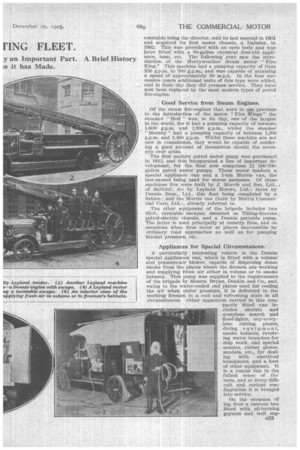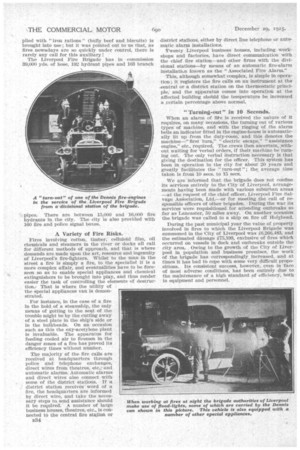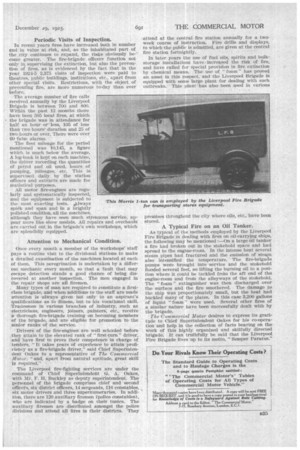LIVERPOOL'S FIR LING FLEET.
Page 16

Page 17

Page 18

Page 19

If you've noticed an error in this article please click here to report it so we can fix it.
An Efficient Organization in Which Motor y an Important Part. A Brief History ;s it has Made. of the Brigade and
T00KING backward it does not seem long ago that 4 every morning and evening, on the stroke of midday and eight o'clock, groups of people, including a big proportion of the younger element, used to congregate outside the Central Fire Station, Hatton Garden, Liverpool, to await the practice ring of the firealarm bells. At the sound of the bells sliding doors shot open, and several pairs of horses dashed forward from their stables at the rear of the engines to their appointed places under the traces of the fireLengines, ready for the drivers to release the harness suspended by spring clips and fasten the collars, while the engine crews manned the vehicles. The practice concluded, the firemen, much to the envy of small boys amongst the admiring onlookers, gave each of the horses a couple of pieces of lump sugar, after which
• they contentedly flufted back to their stables. It was all a matter of seconds.
Losses Only 1 Per Cent. of Total at Risk.
That must have been something like fifteen or more years ago. In the interval the organization has undergone a complete metamorphosis, the contrast In which is all the more piquant when one has earlier recollections to draw upon. Yet in one respect the Liverpool Fire• Brigade vindicates an unbroken tradition. With all the changes that have taken place efficiency has been the sole objective, and that fire losses should be only a trifle over 1 per cent, of potential total losses last year gives some idea of how well that policy has been interpreted.
The year 1916 saw the last of the horse-drawn fire engines then at a district station of the brigade.
The area covered by the Liverpool Fire Brigade embraces 21,242 acres and a population of 808,118. The Central Fire Station is situated at the centre or axis of the city, which, for fire-fighting purposes, is organized divisionally, with fan-shaped sections extending outward from the headquarters in Hatton Garden—six miles northerly, six miles easterly and seven miles southerly:
Six District Stations in the City.
There are six district fire stations in use, and another is in course of erection and is expected to be
opened next year (1926). Each of the divisional stations has a "first turn" petrol motor pump, carrying an escape and other subsidiary appliances, and is in charge of an inspector, sergeant and from seven to twelve men.
'The district stations are so situated that the average distance to the boundaries is from 1 to li with tile exception of two on the outskirts covering large suburban areas, where the distance is slightly in excess of this mileage; but this is compensated for by the provision of sub-reel stations, with first-aid appliances and manned by auxiliary firemen.
In a city with such cosmopolitan interests as Liverpool, with its huge docks and sheds, warehouses, st or e works, shipping, etc., the risk of enormous losses through fire is very red, and can only be minimized by the employment of plant of the most efficient type and the application of the provisions of the city's Fire Prevention Act, which dates back to 1842.
The Liverpool Police Fire Brigade, which comes under the jurisdiction of the fire police committee (a sub-committee of the watch committee), the chief /332 constable being the director, sold its last manual in 1901 and acquired its first motor chassis, a Daimler, in 1902. This was provided with an open body and was later fitted with a 60-gallon chemical first-aid appliance, hose, etc. The following' year saw the introduction of the Merryweather steam motor "Fire King." This machine had a pumping capacity of from .350 g.p.m. to 500 g.p.m., and was capable of attaining a speed of approximately 30 m.p.h. In the four successive years additional units of this type were added, and In their day they did yeoman service. They have now been replaced by the most modern types of petrol fire-engine.
Good Service from Steam Engines.
Of the steam fire-engines that were in use previous to the introduction of the motor "Fire Kings" the steamer " Holt " was, in its day, one of the largest in the world, for it had a pumping capacity of between 1,600 g.p.m. and 1,800 g.p.m., whilst the steamer " Hornby " had a pumping capacity of between 1,200 g.p.m. and 1,400 g.p.m. Whilst these machine are not now in commission, they would be capable of rendering a good account of themselves should the necessity ever arise.
The first modern petrol motor pump was purchased in 1912, and this inaugurated a line of important development, for the fleet now comprises 11 500-700gallon petrol_ motor pumps. Three motor tenders, a special appliance van and a 1-ton Morris van, the last-named being used for stores purposes. Of these machines five were built by S. Morris and Son, Ltd., 4 of Salford ; six by Leyland Motors, Ltd.; three by Dennis. Bros., Ltd., this fleet being completed by a Selden"; and the Morris van (built by Morris Commercial Cars, Ltd.), already referred to.
The other equipment of the brigade includes two 85-ft. turntable escapes, nYounted on Tilling-Stevens petrol-electric chassis, and a Dennis portable pump. The latter is used principally at country fires, and on , occasions when fires occur at places inaccessible by ordinary road approaches as well 'as for pumping flooded premises, etc.
Appliances for Special Circumstances.
A particularly interesting vehicle is the Dennis special appliances van, which is fitted with a volume and pressure-air blower, capable of dispersing dense smoke from the places where the firemen are working and supplying fresh air either in volume or to smoke helmets. This pump was supplied to the requirements of the brigade by Messrs. Bryan, Donkin and Co., and, owing to the water-cooled end plates used for cooling. the air when under pressure, it is delivered to the working firemen in a cool and refreshing state in all circumstances. Other apparatus carried in this coin.pactly -fitted van " includes electric and acetylene search and • flood-lights, oxy-acety7. _lene cutting plants, diving equipment, smoke helmets, revolving water branches for ship work, and special nozzles, rubber gloves, sandals, etc., for dealing with 'electrical breakdown, and a host
• of other equipment. It is a rescue van in the fullest sense of the term, and at. every difficult and serious conflagration it is brought into service.
On the occasion of big, fires a canteen box • fitted with oil-burning • geysers and well supB33 • plied with " iron rations (bully beef and biscuits) is brought into use ; but it was pointed out to us that, as fires nowadays are so quickly under control, there is rarely any call for this auxiliary The Liverpool Fire Brigade has in commission 39,000 yds. of hose, 192 hydrant pipes and 163 branch pipes. There are between 15,000 and 16,000 fire hydrants in the city. The city is also provided with 160 fire and police signal boxes.
• A Variety of Fire Risks.
Fires involving cotton, timber, celluloid film, oil chemicals and steamers in the river or docks all call for different methods of approach, and that is where demands are made upon the art, resource and ingenuity of Liverpool's fire-fighters. Whilst to the man in the street a fire is simply a fire, to the specialist it is a more complex affair, and eventualities have to be foreseen so as to enable special appliances and chemical extinguishers to be brought into play, and thus render easier the task of controlling the elements of destruction.That is where the utility of the special appliances van is demonstrated.
• For instance, in the case of a fire in the hold of a steamship, the only means of getting to the seat of the trouble might be by the cutting away of a steel plate in the ship's side or in the bulkheads. On an occasion such as this the oxy-acetylene plant is invaluable. The apparatus for feeding cooled air to firemen in the danger zones of a fire has proved its efficiency times without number.
The majority of the fire calls are received at headquarters through police and telephone exchanges, direct wires from theatres, etc.; and automatic alarms. Automatic alarms and direct wires also connect with some of the district stations. If a district station receives word of a fire, the headquarters are informed by direct wire, and take the necessarY steps to send assistance should it be required. A number of large business houses, theatres, etc., is connected to the central fire station or
P.34 district stations, either by direct line telephone or automatic alarm installations.
t'wenty Liverpool business houses, including workshops and factories, have direct communication with the chief fire station—and other firms with the divisional stations—by means of an automatic fire-alarm installatien known as the "Associated Fire Alarm."
This, although somewhat complex, is simple in operation; it registers the fire calls on an instrument at the central or a district station on the thermostatic principle, and the apparatus comes into operation at the affected building shohld the temperature be increased a certain percentage above normal.
"Turning-out" in 10 Seconds.
When an alarm of flee is received the nature of it requires, on many occasions, the turning out of various types' of machine, and with the ringing of the alarm bells an indicator fitted in the engine-house is automatically lit up from the duty-room; andthis denotes the machine—" first turn," "electric escape," "assistance engine," etc., required. The crews then ascertain, without waiting for verbal orders, if their machine be turning out. The only verbal instruction necessary is that giving the destination for the officer. This system has been in operation in the city for about 20 years and greatly facilitates the " turn-out "; the average time taken is from 10 secs. to 15 secs.
We are informed that the brigade does not confine its services entirely to the City of Liverpool, arrangements having been Made with various suburban areas —at the request of the chief officer, Liverpool Fire Salvage AsAociation, Ltd.—or for meeting the call of responsible officers of other brigades. • During the war its services were requisitioned for attending outbreaks so far as Lancaster, 50 miles away. On another occasion the brigade was called to a ship on fire off Holyhead.
During the past municipal year the value of property involved in -fires to which the Liverpool Brigade was summoned in the city of Liverpool was £6,266,483, and the estimated damage £75,193, exclusive of fires which occurred on vessels in dock and outbreaks outside the city area.. Owing to the growth of the City of Liverpool in population and business premises, the work of the brigade has correspondingly . increased, and at times it has had to cope with some very difficult propositions. Its consistent success, however, even in face of most adverse conditions; has been entirely due to the maintenance of. a high standard of efficiency, both in equipment and personnel. Periodic Visits of Inspection.
In recent years fires have increased both in number and in Value at -risk, and,as the inhabitated part of the :city continues to expand, the risks obviously become greater. The fire-brigade officers function not only in, supervising the extinction, but also the prevention of fires, as is evidenced by the fact that in the year 1924-5 2,375 visits of inspection were paid to theatre8, public buildings,institutions, etc., apart from other special visits. Restrictions, with the object, of preventing fire, are more numerous to-day than ever before.
The average number of fire calls received annually by the Liverpool Brigade is between 700 and 800. Within the past 12 months there have been 505 local fires, at which the brigade was in attendance for half an hour or less, 105 of less than two hours' duration and 25 of two hours or over. There were over 60 false alarms.
The fleet mileage for the period mentioned was 10,1.45, a figure which is much below the average. A log-book is kept on each machine, the -driver recording the quantities of petrol and oil used, hours of pumping, mileages, etc. This is supervised daily by the station officers and extracts are made for statistical purposes.
All motor fire-engines are regularly and systematically inspected, and the equipment is subjected to the most exacting tests. ,tilways spick and span and in a brightly polished condition, all the machines, although they have seen much strenuous service, appear more like show models. All repairs and overhauls are carried out in the brigade's own workshops, which are splendidly equipped.
Attention to Mechanical Condition.
Once every month a member of the workshops' staff pays a routine visit to the divisional stations to make a detailed examination of the machines located at each of them. This peregrination is undertaken by a different mechanic every month, so that a fault that may escape detection stands a good chance of being discovered at another inspection. The men engaged in the repair shops are all firemen.
Many types of man are required to constitute a firstclass brigade; and.when.tolditiousto the staff are made attention is always given hot only to an aspirant's qualifications as to fitness; but to his vocational skill. Tradesmen in various branches of industry, _such as electricians, engineers, joiners, .painters, etc., receive
• a' thorough fire-brigade training on beComing members of the brigade, _and are eligible for promotion to the senior ranks of the service.
Driver S of the fire:engines are well schooled before . they attain to the elevated rank of " first-turn " driver,. and have first to prove their competence in charge of tenders. "It takes years of experience to attain proficiency as a fire-brigade driver," said Chief Superintendent Oakes to a. representative of The Commercial Motor, "and, apart from natural aptitude, great skill is required."
The Liverpool fire-fighting services are under the command of Chief Superintendent G. A. Oakes, with Mr. F. H. Buckley as deputy superintendent. The personnel of the brigade comprises chief and second officers, six district officers, 14 sergeants, 116 constables, Six motor drivers and three supernumeraries. In addition, there are 120 auxiliary firemen (police constables), Who are indicated by a badge on their tunics. The auxiliary firemen are distributed amongst the police divisions and attend all fires in their districts. They
attend at the central fire station annually for a twoweek course of instruction. Fire drills and displays, to which the public is admitted, are given at the central fire station fortnightly.
In later years the use of fuel oils, spirits and bulkstorage installations have • increased the risk of fire, and have called for special provision in fire extinction by chemical means. The use of " foam " has proved an asset in this respect, and the Liverpool Brigade is equipped with some large plant for dealing with such outbreaks. This plant has also been used in various premises throughout the city where oils, etc., have been stored.
A Typical Fire on an Oil Tanker.
As typical of the methods employed by the Liverpool Fire Brigade in dealing with fires on oil-carrying ships, the following may be mentioned :—On a large oil tanker a fire had broken out in the stokehold space and had spread to the engine-room. In the intense heat several steam pipes had fractured and the emission of steam also intensified the temperature. The fire-brigade pumps were brought into service and the stokehold flooded several feet, so. lifting the burning oil to a position where it could be tackled frOm the aft end of the engine-room and from the alleyways of the stokehold. The " foam " extinguisher was then discharged over the surface and the fire smothered. The damage lo the ship was proportionately small, but the heat had buckled riaany of the plates. In this ease 3,200 gallons of liquid " foam " were used. Several other fires of a sander nature have been successfully dealt with by the brigade.
The Commercial Motor desires to express its gratitude to Chief Superintendent Oakes for his co-operation and help in the collection of facts bearing on the work of this highly organized and skilfully directed brigade. It can truthfully be said that the Liverpool Fire Brigade lives up to its motto, " Semper Paratus."






























